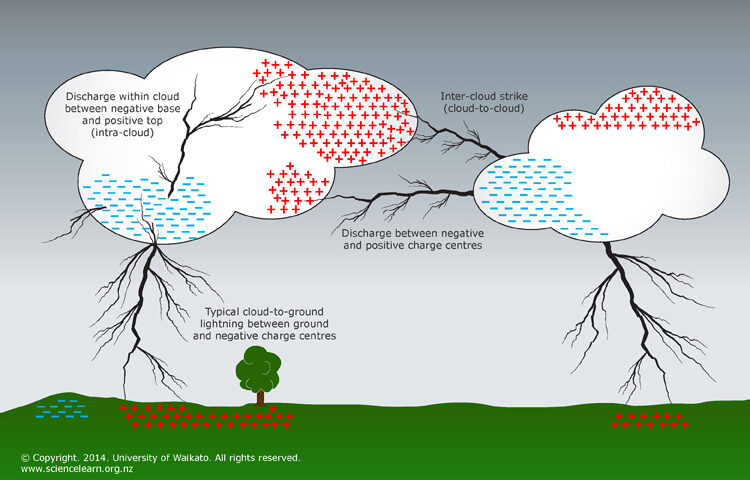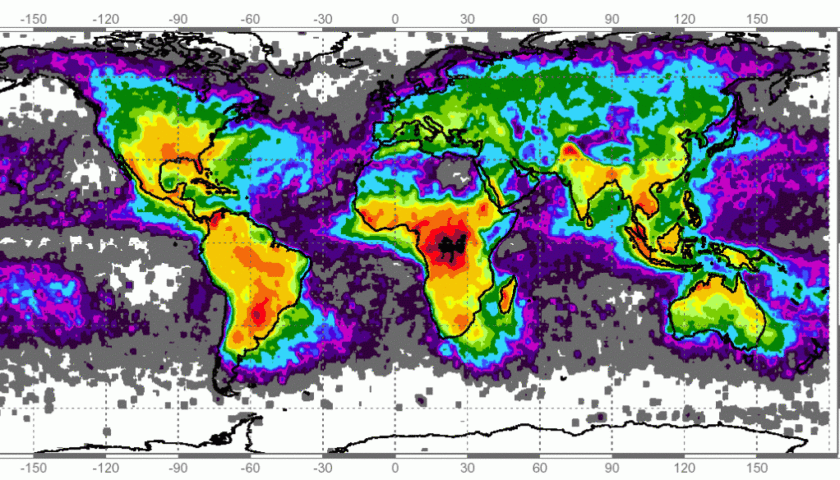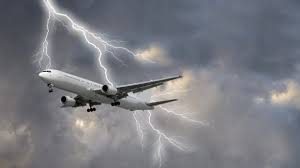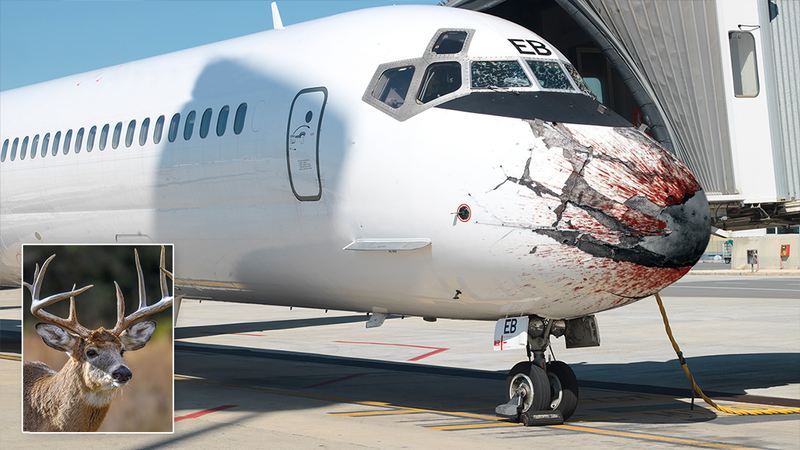Lightning is an atmospheric discharge of electricity. A lightning strike during flight can be very distressing to passengers and crew, and cause damage to an aircraft. The lightning strike very rarely compromise the safety of the aircraft.

Lightning occurs as a result of a build up of static charges within a Cumulonimbus (Cb) cloud, often associated with the vertical movement and collision of ice particles (Hail), which result in a negative charge at the base of the cloud and a positive charge at the top of the cloud. Beneath the cloud, a “shadow” positive charge is created on the ground and, as the charge builds, eventually a circuit is created and discharges takes place between the cloud and the ground, or between the cloud and another cloud. An aircraft passing close to an area of charge can initiate a discharge and this may occur some distance from a Thunderstorm.
Conditions for Lightning Strike on aircraft
A study of lightning strike incidents on the aircraft show that strike are more likely when aircraft is flying in the vicinity of Cumulonimbus cloud (precipitation and turbulence increases the probability) and below 20000 ft. A lightning strike is imminent when a combination of the following conditions is present:
- Flight through or near unstable air, a stationary front, a cold front, a warm front or a squallline.
- Within a cloud.
- When Precipitation or Hail is present.
- Air temperature near 0°C
- Progressive build-up of radio static.
- Visible St Elmo’s fire (when dark).
- Turbulence.
- At altitudes between 5000 ft and 15,000 ft (most prevalent at around 11,000ft).
The following map shows the uneven distribution of lightning strikes across the globe. The data is from space-based sensors. Map showing the uneven distribution of lightning strikes across the globe.

Lightning usually attaches to or enters an aircraft at one point – often an extremity – and exits from another. That is the current flows into one point of the aircraft and out of another. The entry point might be either an anode or a cathode, that is, a spot where electrons are either entering or exiting the aircraft. As the aircraft is moving, the entry and exit point may change during the life time of flash (lightning). Therefore for any one flash, there may be many entry or exit points.
On an average, each airplane is stuck by lightning more than once in a year (McGill 2001). Most aircraft skins consist primarily of aluminum, which conducts electricity very well. Bonding cables are used to create conductive path between various aircraft parts thus preventing electric hazards and shocks. When advanced composite structures are present which are significantly less conductive than aluminium, embeded layer of conductive screens are used to carry current.

Static wicks, also called static dischargers, are devices used to remove static electricity from aircraft in flight. They take the form of small sticks pointing backwards from the wings, and are fitted on almost all aircraft. This continuous discharge from aircraft allows uninterrupted operation of navigation and radio communication equipment.

Lightning strike (high current – 20,000 amperes) traveling on the exterior skin of an aircraft has the potential to induce transients into wires or equipment beneath the skin. These transients are called lightning indirect effects. The aircraft equipment is protected against these transients by careful shielding, grounding and the application of surge suppression devices. The serviceability of these is ensured through proper maintenance activity.
Lightning Effects on Aircraft
- Aircraft Damage. Structural damage to aircraft from Lightning strikes is rare and even more rarely of a nature that threatens the safety of the aircraft. Nevertheless, there have been many incidents of lightning strikes leaving puncture holes in the radomes and tail fins of aircraft (entry and exit holes) and damage to control mechanisms and surfaces.
- Crew Incapacitation. Momentary blindness due to the lightning flash, especially at night, is not uncommon.
- Interference with Avionics. A lightning strike can effect avionics systems (particularly compasses), electrical system, autopilot disconnection.
- Engine Shutdown. Transient airflow disturbance associated with lightning may cause engine shutdown on both FADEC and non-FADEC engines on aircraft.
Crew Actions and Defences
- Avoidance. Follow the standard advice to remain at least 20 nautical miles displaced from any Cumulonimbus (Cb) cloud. The dangers from Turbulence, Low Level Wind Shear, and In-Flight Icing associated with Cumulonimbus clouds are far greater than the threat of Lightning.
- Certainly a lightning strike can be unnerving. The flash can be blinding and your vision can be lost for as long as 30 seconds. If you are flying in the conditions discussed above, especially at night, it’s a good idea to employ the time-honored procedure to protect vision near thunderstorms: Lower the seat, drop the visors, adjust the cockpit lights to full bright, and keep your attention focused inside the aircraft.
- A Lightning strike may cause failure of aircraft equipment. As a pilot, you should deal with major failures stemming from a lightning strike the way you handle a similar failure at any other time. Do the critical stuff first, hit the memory items, follow up with checklists and remember the old admonition to aviate, navigate and then communicate.
- Inform the passengers about the lightning strike and calm them down.
- Do not forget to make an entry in aircraft log book. Last but not the least, raise a flight safety report.
The State Regulatory authorities needs to focus on collecting, processing, and transmitting significant weather (wind shear, micro-bursts, storm cells and lightning information) information to crew in real time.
Be Safe. Fly Safe
Reference:
- Wayne L. Golding, (Fall 2005), Lightning Strikes on Commercial Aircraft: How the Airlines Are Coping, Embry Riddle Aeronautical University, Journal of Aviation/Aerospace.
- J. McGill, (200 1, Aug 20), What happens when lightning strikes an airplane? Scient~jic American Inc., 1.
- Clarence E. Rash, Flight Safety Org, When Lightning Strikes.
- Airbus, Safety First, Lightning Strikes.



